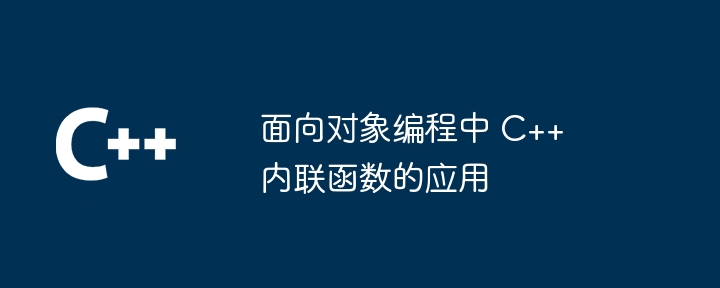Home >Backend Development >C++ >Application of C++ inline functions in object-oriented programming
Application of C++ inline functions in object-oriented programming
- WBOYWBOYWBOYWBOYWBOYWBOYWBOYWBOYWBOYWBOYWBOYWBOYWBOriginal
- 2024-04-16 10:03:011095browse
Inline functions are a useful tool for improving the efficiency of method calls in OOP because they are expanded at compile time, avoiding the overhead of function calls. When declaring an inline function, just add the inline keyword before the function definition. The advantages of inline functions include improved performance, reduced code size, and improved readability. However, when using it, you need to pay attention to potential code bloat, increased compilation time, and optimizer interference.

C Application of inline functions in object-oriented programming
Inline functions are expanded at compile time, not every time A function that is re-executed when called. This can significantly improve program performance, especially when the function is called frequently. In object-oriented programming (OOP), inline functions are particularly useful because they make method calls more efficient.
Declaration of inline functions
To declare an inline function, just add the inline keyword before the function definition. For example:
inline int square(int x) {
return x * x;
}Advantages of inline functions
Inline functions have the following advantages:
- Improving performance:When functions are called frequently, inline functions can avoid the overhead of function calls, thus improving program performance.
- Reduce code size: Because inline functions are expanded at compile time, it does not increase the size of the target code.
- Improve readability: Inline functions allow you to keep the code where it is called, thereby improving readability.
Practical case
Consider a class that calculates the area of a circleCircle:
class Circle {
public:
double radius;
// 计算面积
inline double area() {
return 3.14159 * radius * radius;
}
};In this case, area Methods are declared as inline functions. This means that every time an area method is called, the compiler expands the function body at the call site. This improves program performance because the compiler does not have to create new stack frames or make function calls for area methods.
Notes
Although inline functions have many benefits, there are also some considerations:
- Code bloat:If the inline function body is large, it may cause code expansion and affect the performance of the program.
- Increased compilation time: Inline functions need to be expanded at compile time, which may increase compilation time.
- Optimizer interference: Inline functions may interfere with the compiler's optimization, resulting in performance degradation.
Overall, inline functions are a valuable tool in C OOP to improve method calling efficiency and program performance. However, when using inline functions, you should consider its advantages and caveats.
The above is the detailed content of Application of C++ inline functions in object-oriented programming. For more information, please follow other related articles on the PHP Chinese website!

